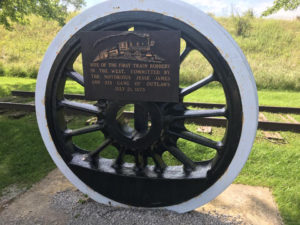THE FIRST TRAIN ROBBERY
As the “rail road” was developing in the mid-1800s, it was inevitable an accident would occur. The Providence and Worcester Rail Road has the unfortunate distinction of recording the nation’s first head-on train accident near Pawtucket, Rhode Island. There were no engineer-operated braking systems on the cars, with only brakemen to manually turn a large wheel to apply brakes to each individual car. Electricity remained a novel laboratory experiment and use of kerosene lanterns to illuminate colored glass signals had not been thought of. Rails worked loose to derail trains, and the violent bouncing of wooden coaches heated by coal- or wood-fired potbelly stoves within often burst into flames. In severe accidents, cars might “telescope” where they folded into each other, similar to the spy glasses of the era. Chances of surviving a railroad accident were indeed minimal in America until the 1900s.
While a railroad accident was perhaps the top fear for passengers, the threat of a train being held up and the passengers robbed grew as more people used rail travel and the railroads transported goods and materials of greater value in their cars. In what year was the first railroad robbery committed?
ANSWER
The books of the late 1800s and the movies of the mid-1900s have tended to embellish the typical train robbery of the the late 1800s. Riding alongside a moving train and jumping aboard was a dangerous proposition. It was far easier for robbers to buy a ticket and board as a paying passenger to gain access to a train to be robbed. A few robbers could take over a train and bring it to a stop at a prearranged location where other gang members could board and not only relieve passengers of their gold jewelry and other valuables but dynamite safes in baggage or box cars.
The first train robbery in America most often cited to have taken place occurred on October 6, 1866. An Ohio & Mississippi Railroad train headed eastbound near Seymour, Indiana, was robbed by a gang of thieves led by the Reno brothers. Donning masks and displaying guns, they took control of the Adams Express Company car. After taking the keys to the local valuables safe and emptying it, they tossed the “thru passage” safes off the car for later opening. They signaled the engineer to stop the train, got off, and escaped into the night.
According to records with the Smithsonian Institution, the first railroad robbery occurred in January 1866. An unattended Adams Express car with safes containing over a half-million dollars of assorted valuables were emptied of their contents as the train traveled from New York City to Boston. The first movie to depict a train robbery was a 12-minute short silent film produced by the Edison Studios called The Great Train Robbery, written, produced, and directed by Edwin S. Porter. The original film has been preserved by the U.S. National Film Registry by the Library of Congress as a “culturally, historically, and aesthetically significant” piece of American cultural history.
Waukee, Iowa, has erected a monument to “the first train robbery in the west.” The Jesse James Gang robbed a Rock Island Railroad train on July 21, 1873, by pulling up the spikes holding the rails to the ties. When the engine lost its footing on the loose rail, it flipped on its side, killing the engineer and injuring the fireman. As their first attempt at a train robbery, it netted the gang $2,000 cash in the safe and passenger valuables and currency.

